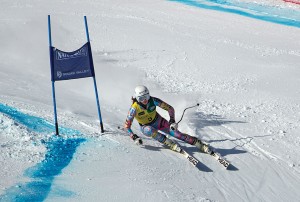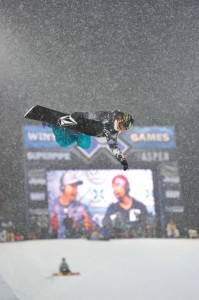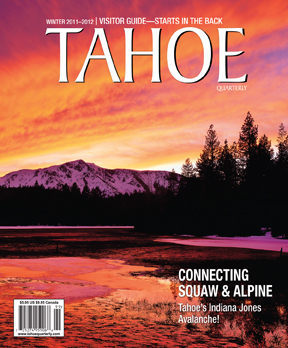Olympics 2014: Olympic Dreams for Tahoe/Reno Athletes
A plethora of Tahoe athletes hope to represent the United States in Russia
(Ed’s Note: This story went to press before the Olympic teams were announced, so any athlete who made the teams will have an * next to their name in this story.)
Written by Alison Bender
On Friday, the best athletes in the world will convene in Sochi, Russia, for the opening ceremonies of the XXII Olympic Winter Games. Representatives from the Lake Tahoe region, certain to be in attendance, will travel some 6,000 miles—a quarter-way around the planet—to arrive at the Black Sea resort city. The Sierra Nevada made these skiers and snowboarders ready to speed, bump, slalom and jump down the snow-capped peaks of the Caucasus Mountains.
For the athletes attending, the Winter Games aren’t an occasional opportunity, but the result of years—often decades—of rigorous preparation: years of pushing oneself to go a little harder, a little longer, a little faster; overcoming injuries and opposition; obtaining sponsors; trading free time for training time; and competing in dozens or hundreds of qualifying events, World Cups, X Games and other races.
The U.S. Olympic teams were officially selected at the Grand Prix in mid-January. To qualify, an athlete must first land a top 30 position at a World Cup event and achieve a minimum FIS (International Ski Federation) point total, which varies within disciplines. From there, athletes are determined based on their top two results out of the five Olympic qualifying events (the Dew Tour and four Grand Prix). Though some think they know who will make the final cut, “there are always surprises and it is very hard to speculate who will be on the team,” says United States Ski and Snowboard Association (USSA) press officer Justine Spence.
Here’s a look at some of the local athletes who may represent Lake Tahoe—and the country—in the disciplines of alpine skiing, snowboarding, freestyle and freeskiing at the Winter Games:
Alpine Skiing
Within the discipline of alpine skiing, events include downhill, super-G, slalom and the super combined. Sochi’s Rosa Khutor Alpine Resort—which boasts a vertical drop of 5,774 (more than a mile)—will host the races. Former Olympian Bernhard Russi designed the race courses, just as he designed every Olympic downhill course since 1988.
Marco Sullivan* is one Tahoe skier who hopes to take on the Rosa Khutor course. The 33-year-old Truckee resident previously competed in the 2002 and 2010 Olympic Games. “I know that this will be my last Olympics, so I am putting everything into it,” Sullivan says. “I am feeling strong and healthy, so of course I will be aiming for the podium in Sochi.” The racer, who hopes to compete in both the downhill and super-G events, moved to Park City, Utah, for the summer to train fulltime at the USSA Center of Excellence facility. “We spend a lot of time on general fitness,” Sullivan says. “Of course, for skiing, there are a lot of core and leg strength workouts. We also traveled to Chile twice this summer for on-snow training. We will be on snow again as soon as the ski resorts in Colorado open up, and after November we will be racing almost every weekend on the World Cup Tour, the results from which will determine whether or not we earn a spot on the Olympic squad.”
The possibility looks good for Sullivan, who earned a third-place finish at the Lake Louise Audi FIS World Cup downhill last year, his first podium since 2009.
Truckee native Stacey Cook*, a member of Mammoth Mountain Ski Team, also hopes to attend her third Olympics. “All three Olympic preparations have been very different for me,” says the 29-year-old athlete (“Cookie” to her fans), who competes in downhill and also hopes to qualify for super-G and super combined. “My first Olympics in 2006, I went as a surprise. The summer before, I was thinking it would be so cool, but probably not too realistic. When I made the team, I was so excited and wide eyed at the whole experience.”
Cook finished 19th in downhill and 23rd in giant slalom.
“For the 2010 Olympics, I was coming off the worst year of my career in 2009. I had contemplated quitting, but knew I had more left in me. I had a very focused and hard-working summer that year and had quite a comeback year.”
Cook arrived in Vancouver ready to race. Unfortunately, less than a week before the Olympics, she lost control on a jump during a snowy training run and flew into the safety netting, then had to be airlifted off the course. Despite her concussion, she returned to the slopes just a few days later and finished 11th in the downhill, the same event where Americans Lindsey Vonn and Julia Mancuso* took gold and silver, respectively.
“I had confidence going into those Games that I could medal,” says Cook. “Obviously, crashing put a damper in those expectations, but I learned a lot from that experience. This time around, I am coming off of my best season ever. I am ranked 4th in the world in downhill and consider myself a medal contender. There is a lot more that goes with those expectations, but I am relying on all my past experience to keep a cool head, and just get done what needs to get done.”
To that end, Cook trained hard throughout the summer, putting in “hours and hours and hours of work” at the gym and on the bike. “It hasn’t been my most fun summer ever as far as adventures go,” she says, “but I figure I just need to put my head down for a few more months and then there will be all the fun in the world to be had!”
Other possible Lake Tahoe alpine skiers include Mancuso (“Super Jules” to fans), the most decorated Olympic female American alpine skier at three medals—a gold in the giant slalom from the 2006 Winter Olympics and silver medals in both downhill and combined in 2010—and her Squaw Valley Ski Team teammate Travis Ganong*. Other names to watch out for include Squaw skier Nick Daniels and Reno native Tim Jitloff*, who races with the Park City Ski Team, as well as Bryce Bennett, Keith Moffat and Foreste Peterson, all members of the Squaw Valley Ski Team, and Incline Village’s Lila Lapanja.
Snowboarding
Snowboarding events such as halfpipe, slopestyle and snowboarder-cross, parallel giant slalom and parallel slalom take place at Sochi’s Rosa Khutor Extreme Park.
Elena Hight, a 24-year-old athlete out of Incline Village, hopes to represent the U.S. on the halfpipe. Already a two-time Olympian and a member of the Northstar California Pro Team, Hight spent the fall focusing on strength training, yoga, running and biking to ensure she’s in top shape going into the season. “The Olympics are like no other sports venue out there,” she says. “To represent your country on such a large scale is an amazing thing.”
Born in Kauai, Hawaii, Hight moved to the South Shore at a young age. “The first thing my dad did was teach us all to snowboard,” she says. “I remember loving snowboarding almost immediately and it just became a huge part of my life after that.”
Watch for her signature double backside alley-oop rodeo, which she became the first snowboarder—male or female—to land during a 2013 SuperPipe X Games competition in Aspen. The move earned her a silver medal. “I think that will be the most influential part of my riding to watch for,” she says.
Like Hight, Hannah Teter* also hopes to represent the U.S. for a third time. The South Lake Tahoe resident trains at Sierra-at-Tahoe and will turn 27 just before the Games. She says her four older brothers and her mother, a ski patrol nurse, made it “inevitable” for her to start riding at a young age. “I skateboarded first, and I think that the correlation between the two helped me to excel rapidly. Also, my pro snowboarder brothers helped teach me to ride pipe, and I’ve watched them compete since I was a little kid.”
Teter prepares for a race with visualization and stretching; her training involves agility, core and balance exercises.
A Vermont native, Teter attended her first Olympics at the 2006 event in Turin, Italy, where she won gold in the halfpipe; she won silver for her 2010 performance in Vancouver. “It was the craziest moment of my life,” says Teter of winning gold, “where I excelled beyond my wildest dreams. It’s an indescribable moment that will be burned in my brain forever.” She used her winnings and founded Hannah’s Gold Maple Syrup, which, between proceeds from the syrup and Teter’s competition winnings, funds projects, such as a clean water effort, for the impoverished town of Kirindon, Kenya.
Another big name in the halfpipe world, 27-year-old Shaun White* already boasts two gold medals for his halfpipe performances in Turin and Vancouver and more than a dozen X Games gold medals in slopestyle and superpipe. White aligned himself with the Northstar California Pro Team in 2011 and spent the past few winters training at the resort’s 22-foot superpipe that he helped design. He injured his ankle while practicing at a qualifying event in New Zealand in August, but hopes to qualify for both halfpipe and slopestyle.
The 2014 Games mark the Olympic debut of slopestyle for both snowboard and ski. Slopestyle competitions take place on a course of rails and jumps where athletes perform tricks. Besides White, other local slopestyle contenders include White’s Northstar teammate and Reno native Chas Guldemond*, Truckee resident Ryan Stassel and South Lake Tahoe’s Jamie Anderson*, who won X Games gold four times in slopestyle, and medaled seven times in the past eight years. In snowboarder-cross, watch out for Squaw Valley’s brother duo of Nate* and Pat Holland.
Freestyle
Within the overarching term “freestyle,” recognized Olympic events include moguls, aerials and ski cross.
Mogul skier Sho Kashima moved to South Lake Tahoe, just five minutes from Heavenly, at age four and got his first ski pass that year. A graduate of George Whittell High School, the 27-year-old Kashima now attends school at Westminster College in Park City, Utah. A torn ACL in his left knee in January 2010 ended his efforts at the Vancouver Winter Games; in January 2012, he tore his right ACL, meniscus and broke his right knee. In the two years since, Kashima has recovered from his injuries and hopes to compete in moguls in Sochi.
“The U.S. will get up to four spots to enter into moguls,” Kashima says. “I understand that we have the best team in the world, and I respect how deep our talent is within the U.S. team, but I like my chances. My goal isn’t just to make the team, but I’d love to bring home a medal to Heavenly.”
Another hopeful, 19-year-old Tiburon, California, native Ali Kariotis competes with the Squaw Valley Freestyle Team. “I am really looking forward to the upcoming season,” she says. “Being an Olympic year, the level of competition will be substantially higher than most seasons. I definitely have a lot of hard work ahead of me to make it to Sochi, but I am excited for the challenge.”
Kariotis spent the summer on the water ramp—a ski jump into a pool that allows athletes to practice in warm weather and land on the relative softness of water versus packed snow—in Park City, and trained on-snow at Mt. Hood, Oregon, and Whistler, British Columbia.
“The most important strategy to mogul skiing is mental preparation and focus,” says Kariotis. “A mogul run is only 30 seconds, but being mentally prepared to perform allows me to train and compete at my highest level.”
Tahoe City skier Scotty Bahrke hopes to compete in aerials. Bahrke followed his older sister, Olympic 2002 silver medalist and 2010 bronze medalist Shannon Bahrke, into the sport and onto the Squaw Valley Freestyle Team. In 2010, after an injury to another skier left an opening just five days before the competition, Bahrke joined as a surprise addition to the men’s aerials team. Bahrke came in 23rd in his debut Olympic event; this past summer, he, like Kariotis, spent time on the water ramp, allowing him to dial in flips and twists he hopes to display in Sochi.
Freeskiing
Within the freeskiing discipline, Olympic events are divided into halfpipe and slopestyle, both of which debut in the 2014 Games.
South Lake Tahoe native Maddie Bowman* has skied for about 18 years, ever since her second birthday. She found her first major successes in 2012, and this year, won X Games gold in the halfpipe, as well as first place in two Grand Prix events.
With so many recent victories, Bowman says, “I try not to focus too much on the success part and enjoy each experience. I don’t want anything to go to my head that would distract from skiing.”
As for her thoughts on her chances? “To represent Tahoe on that stage would be amazing! It’s hard to imagine, but it’s starting to become more of a possibility everyday—which is both an exciting and terrifying thought.”
Reno resident David Wise*, the only skiing member of the Northstar Pro Team, may also get to show off his skills on the halfpipe. “What I really try to do is treat competition days like any other day,” he says of his racing strategy. “I try to ski consistently well, no matter if I’m practicing by myself at Northstar, or competing on the world stage. That way I don’t have to feel pressure.”
Pressure is one thing Brita Sigourney*, a Carmel, California, native who grew up skiing on the Alpine Meadows Freestyle Team, may feel with the looming Olympics. Sigourney already has a history with Sochi. While skiing at the Sochi test event World Cup in February 2013, she fell, breaking her collarbone and injuring her shoulder and her knee. “The beginning was difficult, to say the least,” says Sigourney, who turns 24 just before the Winter Games. “Since I had shoulder surgery three weeks before knee surgery, using crutches and getting around was always painful. It was also difficult to make sure that each injury got enough attention and I felt like I was in a constant state of soreness that switched off between my shoulder and knee. I’m so glad I’m not in that stage anymore. It’s nice to see all the hard work I put into rehabbing and working out all summer finally paying off. I’m feeling stronger than ever and my injuries rarely bother me anymore.”
And despite her last go at Sochi, she’s ready to get back. “Making it to the Olympics would be a huge life accomplishment and dream come true,” she says. “The Olympics have been the motivation that gets me through every difficult workout and every physical rehab process I have experienced in the last two years. The girls I am competing against to make the U.S. Olympic Team are the best skiers in the world and I feel like everyone has an equal amount of potential to make it. It’s going to be a crazy year and I am so ready for it.”
Reno resident Alison Bender is waiting for the day that standing around and cheering while drinking hot chocolate becomes an Olympic event.








